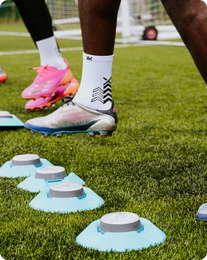Your heart is the powerhouse of your body. Keeping it in top shape doesn’t just benefit your cardiovascular system - it enhances your overall health, energy levels, and even mental well-being. But did you know that the type of exercise you do can have a huge impact on your heart’s health?

In honor of Heart Awareness Month, it’s time to dig into the importance of heart health and explore the exercises that’ll keep your ticker running strong. By the end of this article, you’ll understand:
-
The different types of exercise that benefit the heart
-
How specific exercises improve heart health
-
Why these exercises work for your heart
-
How BlazePod can elevate your heart-health routine
Why Heart Health Matters
We all know that staying active is good for us, but did you know that regular exercise can reduce your risk of heart disease? The heart is responsible for pumping blood throughout the body, supplying oxygen and nutrients to muscles and organs. If it’s not functioning optimally, the rest of the body suffers.
Heart disease remains one of the leading causes of death worldwide. In fact, heart disease is responsible for about 17.9 million deaths annually, accounting for 32% of all global deaths, according to the WHO.
But, regular exercise can lower the risk.
A combination of aerobic, strength, and flexibility exercises keeps the heart pumping efficiently and promotes overall well-being. Let’s break down the exercises that help your heart stay strong and healthy.
Types of Exercise That Keep Your Heart Healthy
Aerobic Exercise
Aerobic exercise, often called “cardio,” involves sustained activity that elevates the heart rate and improves circulation. It’s the cornerstone of any heart-healthy routine.
Why It Works
Aerobic exercise plays a critical role in heart health by improving circulation, which helps blood flow more easily and reduces the workload on the heart. It also lowers both systolic and diastolic blood pressure, reducing strain on the heart.
Studies show that engaging in 150-300 minutes of moderate aerobic exercise weekly can lower cardiovascular disease mortality risk by 22%-25%, while doubling that amount can reduce it by as much as 28%-38%
Additionally, regular cardio boosts aerobic fitness, enhancing the heart’s efficiency by allowing it to pump more blood with fewer beats. This type of exercise is also essential for regulating blood glucose levels, which helps prevent or manage type 2 diabetes, a condition closely linked to heart disease.
Examples of Aerobic Exercises
To get started, activities like running, cycling, swimming, brisk walking, and dancing are fantastic ways to incorporate aerobic exercise into your routine. But if you’re looking to mix it up, try the HB Stair Drill! This drill is perfect for building agility and stamina as you maintain speed throughout the workout.
For this drill, you’ll need a set of stairs - wider steps work best, unless you’re feeling extra bold. Set up four Pods: one at the bottom as your home base, and place the other three on every second step. When a Pod lights up, sprint up the stairs to tap it, then race back down to tap the home base before repeating.
The HB Stair Drill is flexible and can be customized to your fitness level. If you’re new to exercise, place the Pods on the first few steps for a shorter run. For more experienced athletes, spread the Pods across more steps to really challenge your speed and endurance. Just be sure to stay steady on your feet!
Aerobic exercises like the HB Stair Drill are excellent for improving heart function, maintaining a healthy weight, and boosting overall fitness.
Resistance Training
You may think of strength training as just for building muscle, but it also plays a crucial role in improving heart health.
Why It Works
Strength training is equally important for heart health as it reduces fat by increasing muscle mass and boosting metabolism. This reduction in fat eases the burden on the heart.
Strength training also improves cholesterol levels by raising HDL (good cholesterol) and lowering LDL (bad cholesterol), contributing to a healthier cardiovascular system.
Furthermore, by strengthening muscles, it helps reduce strain on the heart by making physical tasks, like lifting or walking, easier to perform.
Examples of Resistance Exercises
You can always stick with the basics - weightlifting, bodyweight exercises, resistance bands, or kettlebells - but if you’re looking to spice things up, try the Resistance Band Power Jumps drill.
Grab a resistance band and prepare to take your power to the next level. Stick with this drill, and you’ll see improvements in your ability to push harder and maintain that power for longer.
For the Resistance Power Jumps drill, tie a resistance band around a sturdy pole. Place three Pods in a straight line: one 2 meters from the pole, the second 1 meter beyond that, and the third 1 meter further. Stand facing the Pods with the resistance band around your waist. When a Pod lights up, jump forward with both feet and squat to tap the light. Focus on driving power through each jump rather than running to the Pods.
This drill is great for building lean muscle, boosting endurance, and improving heart health - helping reduce risks associated with heart disease.
Stretching, Flexibility, and Balance
Stretching and flexibility exercises are often overlooked, but they’re just as important for heart health. Maintaining flexibility ensures that blood circulates properly to all areas of the body, and balance exercises reduce the risk of falls and injury, which can cause complications to heart health.
Why It Works
Flexibility and balance exercises enhance musculoskeletal health by preventing joint pain, muscle cramps, and stiffness, which can hinder daily activities. Stretching can also improve circulation, preventing blood from pooling in the lower extremities, and supporting overall heart function.
Even low-intensity exercises like walking 19 kilometers weekly over seven months have been shown to increase cardiorespiratory fitness by up to 31%, which supports better circulation and heart health.
Additionally, balancing exercises reduce the risk of falls, helping to keep the body stable during physical activities, which in turn reduces potential strain on the heart.
Examples of Stretching and Flexibility Exercises
Yoga, Pilates, dynamic and static stretching - all great for flexibility, but if you’re looking to take your balance and focus to the next level, try the Color Coded Lunge Out drill. This exercise integrates lower body strength, balance, and cognitive function, making it a great way to enhance your agility and improve your mental sharpness.
To set it up, position six Pods in a semi-circle in front of you. Place two Pods 150cm directly to each side, and two Pods 150cm ahead with 50cm in between. The remaining two Pods should go between the side and top Pods to complete the semi-circle.
Stand at the base of the semi-circle, facing the Pods. As the Pods light up, lunge toward the one that matches the color. For the first color, lead with your right foot; for the second, lead with your left. If a side Pod lights up with the opposite color, perform a reverse crossover lunge instead of a side lunge.
This drill challenges your balance, focus, and flexibility, all while working on coordination and reaction time. By regularly practicing, you’ll build stronger, more balanced movements and enhance your ability to stay focused under pressure- improving both your physical endurance and mental clarity.
How BlazePod Enhances Heart Health Training
BlazePod offers an innovative way to combine physical and cognitive training, enhancing both your body and brain’s ability to respond under pressure.
By using light-based prompts, BlazePod drills engage athletes in high-intensity, full-body workouts that challenge the cardiovascular system while improving reaction time, coordination, and agility.
BlazePod Benefits for Heart Health
Interactive and engaging
Light-based drills encourage full-body engagement, making cardio and strength exercises more dynamic.
Real-time feedback
BlazePod tracks your progress, helping you stay motivated and focused while training.
Customizable drills
Whether you want to increase endurance or focus on strengthening, BlazePod allows you to tailor drills to your heart-health needs.
By incorporating BlazePod into your training routine, you can improve cardiovascular health, mental clarity, and cognitive resilience simultaneously.
Conclusion: The Heart of the Matter
Maintaining heart health is about more than just running on a treadmill or lifting weights - it’s about engaging in a variety of exercises that challenge your heart, muscles, and mind. Whether you’re focused on cardiovascular endurance, muscle strength, or flexibility, each type of exercise plays a crucial role in ensuring your heart stays healthy.
Incorporating aerobic exercises, resistance training, and flexibility work into your routine will not only improve your heart health but will also help you become a stronger, more agile athlete. With BlazePod, you can take your training to the next level, combining physical and cognitive exercises to improve your heart health, reaction time, and mental sharpness all at once.
Start incorporating these heart-healthy drills today and track your progress with BlazePod. It’s time to take your heart health to the next level - because a healthy heart means a healthier, stronger you.






















